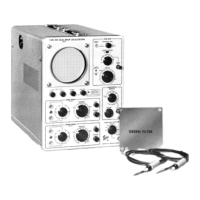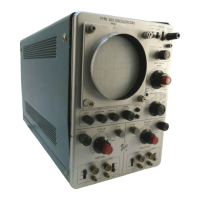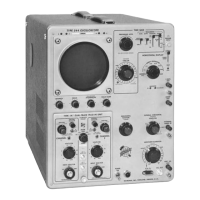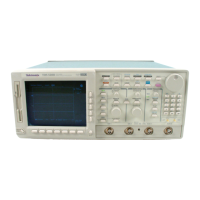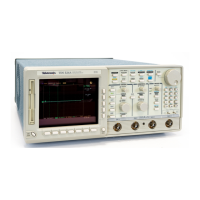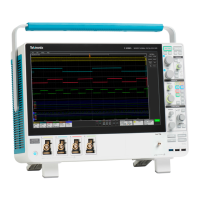5103N
SECTION
4
SYSTEM
MAINTENANCE
Change
information,
if any,
affecting this section
will
be found at
the
rear of the
manual.
Introduction
This
section
of
the
manual
applies to all
instruments
in
the
5100-series
oscilloscope
system,
including display units
and plug-in
units. It
contains
information
for preventive
maintenance,
troubleshooting,
obtaining
replacement
parts,
and replacing
components
and
sub-assemblies.
5100
Panel
Removal
Dangerous
potentials
exist at
several points through-
out the
oscilloscope.
When
the instrument must
be
operated
with the
cabinet
panels
removed, do not
touch
exposed
connections
or
components. Some
transistors
have voltage
present on
their cases. Dis-
connect
power
before
cleaning the
instrument or
replacing parts.
The
cabinet
panels
of the
5100-series
oscilloscope are
held in
place
by
slotted
fasteners. To
remove
the panels,
turn each
fastener
counterclockwise
a
quarter turn
with a
large
screwdriver,
coin,
or
similar
device. Then
the panels
can
be lifted
away.
The
instrument
should be
operated with
the
panels in
place to
protect the
interior
from dust,
and to
eliminate
shock
hazard.
PREVENTIVE
MAINTENANCE
General
Preventive
maintenance,
consisting
of cleaning,
visual
inspection,
etc.,
performed on
a
regular
basis,
will improve
the
reliability
of the
oscilloscope.
Periodic
checks of the
semiconductor
devices
used
in
the system
are not
recom-
mended
as a
preventive
maintenance
measure.
See
semiconductor-checking
information
given
under
trouble-
shooting. A
convenient
time
to
perform
preventive
main-
tenance is
preceding
instrument
calibration.
Cleaning
Avoid
the
use
of
chemical
cleaning
agents
which
might
damage
plastic
parts.
Avoid
chemicals con-
taining
benzene,
toluene,
xylene, acetone,
or similar
solvents.
Exterior.
Loose
dust may
be removed
with
a
soft cloth
or a
dry brush.
Water
and mild detergent may
be used;
however,
abrasive cleaners
should not
be used.
Interior. Cleaning the interior
of the
unit
should
pre-
cede calibration, since the
cleaning process could alter the
settings
of
the
calibration adjustments. Use
low-velocity
compressed air to
blow off
the accumulated dust.
Hardened
dirt
can
be removed
with
a
soft,
dry
brush, cotton-tipped
swab, or cloth
dampened with a water and mild detergent
solution.
Calibration
To
ensure accurate measurements, the
performance
of
individual units comprising
the 5100-Series Oscilloscope
should be
checked periodically. Complete
calibration
instructions
are given in the manuals
for each unit.
The calibration
procedure can be helpful in
isolating
major
troubles in a unit. Moreover,
minor troubles
not
apparent during
regular operation may be
revealed and
corrected during
calibration.
TROUBLESHOOTING
General
The
following is
provided to augment
information con-
tained
elsewhere in this
and
in
other manuals when
trouble-
shooting the
5100-Series
Oscilloscope or its plug-in
units.
The
schematic diagrams,
circuit description
and calibration
sections
should be
used to full advantage.
The circuit
des-
cription
sections
give detailed
information about
circuit
behavior and output
requirements.
Troubleshooting Aids
Diagrams. Circuit
diagrams are
given on foldout
pages
in
the
diagram
section
of each
individual manual. The
circuit
number
and electrical value
of
each
component in this
in-
strument system
are
shown on the
diagrams (see
first page
4-1

